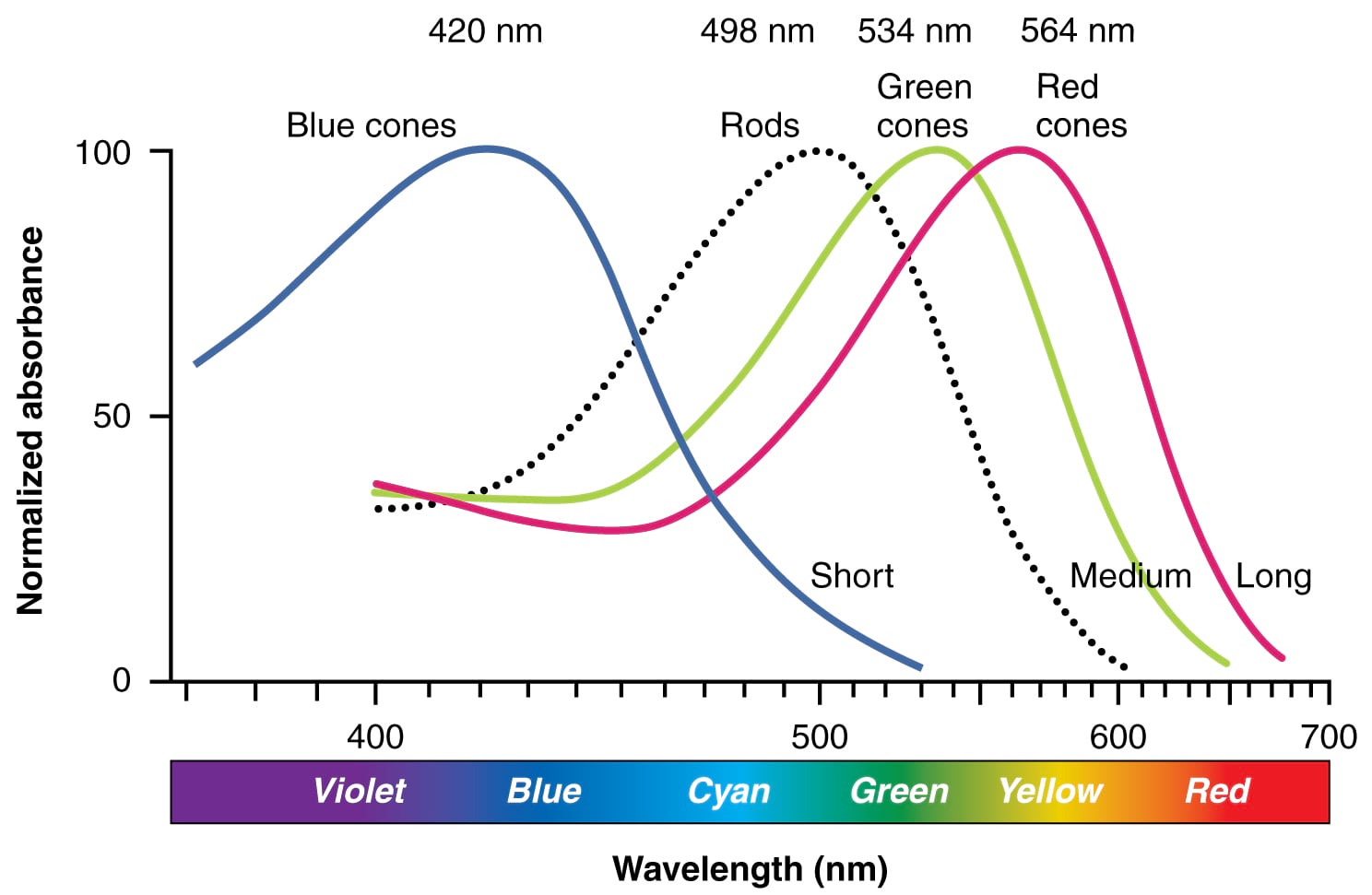Range of Wavelengths to Which Each Cone Type Responds Best
Start studying the Chapter 3 Psych Quiz flashcards containing study terms like The _____ states that there are three kinds of cones in the retina each of which responds primarily to a specific range of wavelengths The _____ play a key role in peripheral vision seeing objects that are outside the. Instead light with a wavelength of light to which we assign the color Blue from 450 to 490 nm give or take actually stimulates each of the three cone types with roughly comparable effectiveness.
Why Are There More Red Cones On The Retina Than Blue And Green Cones Quora
The major range is between 500 nm and 760 nm peaking at 600 nm.
. To which wavelengths of light do the three cone types of the retina respond maximally. This nomenclature implies that individual cones provide color information for. The erythropsin in the red-sensitive cones is sensitive to two ranges of wavelengths.
-respond the most to shorter wavelengths a little to medium wavelengths and not at all to longer wavelengths M-cones -respond best to medium wavelength photons perceived as green to. Rods are about 1000 times more sensitive and their curve peaks at about 500 nm. This includes green yellow orange and red light.
Each of these photopigments has a different sensitivity to light of different wavelengths and for this reason are referred to as blue green and red or more appropriately short S medium M and long L wavelength cones terms that more or less describe their spectral sensitivities Figure 1112. Where is the blind spot optic disc located ian relation to the fovea. The photoreceptors are all sensitive to a broad range of wavelengths albeit different types of photoreceptors have a peak sensitivity at different wavelengths.
Each type of cone cell responds to a range of wavelengths rather than just one and their response curves overlap Figure 2. Identify the range of wavelengths to which each cone type responds best. The third type responds the most to short-wavelength light peaking at 420 nm and is designated S for short and these make up only around 2 of the cones in the human retina.
Identify the range of wavelengths to which each cone type responds best. Where is the blind spot optic disc located ian relation to the fovea. Thus red cones absorb longer wavelengths green cones medium wavelengths and blue cones shorter wavelengths.
The peak sensitivity is broadly in the blue green and red parts of the visible spectrum for the S M and L cones. With each wavelength of light each of the receptors reacts to a different degree and certain receptors prefer one wavelength says Brian Timney PhD a researcher of mammalian vision who is dean of social science at the University of Western Ontario. The Red Cone is 560nm.
Although each cone class responds best to a small range of wavelengths they all respond in some way. The Green Cone is 530nm. Because of this overlap each wavelength of light gives a unique pattern of response in each of the three cone populations and the pattern.
Three kinds of cones are unevenly distributed. The Blue Cone is 420nm. Each cone responds to a broad range of wavelengths but some more than others.
The image shows the relative sensitivity of the three types of cones which are named according to wavelengths of greatest sensitivity. The second most common type responds the most to light of medium-wavelength peaking at 530 nm and is abbreviated M for medium making up about a third of cones in the human eye. More intense light increases the brightness of the color but does not change the ratio.
Evidence for the three types of cones comes from direct measurements in animal and human eyes and testing of color blind people. The ratio of activity across the three types of cones determines the color. Memorize flashcards and build a practice test to quiz yourself before your exam.
Likewise we perceive yellow orange or red depending on the relative activation of green and red cones.

Neuroscience For Kids Color Vision

Spectral Sensitivity An Overview Sciencedirect Topics

Spectral Sensitivity Curves Of Rods And Cones
Is The Range Of Wavelengths The Light Detectors Rods In Our Eyes Can See The Same As The Range Our Colour Receptors Cones Can See If So Is This A Coincidence
Why Are There More Red Cones On The Retina Than Blue And Green Cones Quora

Cone Cells In Human Eye Are Responsible For Color Vision The Cone Cells Are Of Three Types Red R Green G And Blue B Cells Each Type Of Cone Cell Responds To

The Cone Spectral Sensitivity Functions At All Wavelengths In The Download Scientific Diagram
What If Red And Blue Retinal Cones Are Missing Faulty Would You Only See Green Quora

Bending Light And Blending Light
How Do The Cones In Our Eyes Detect Specific Wavelengths Of Light And Why Can T We Just Add More Cones To Expand Our Internal Color Viewing Range Quora

Color And Color Vision Physics

Color And Depth Perception Introduction To Psychology
Which Three Colors Are Cone Cells The Most Sensitive To Quora




Comments
Post a Comment